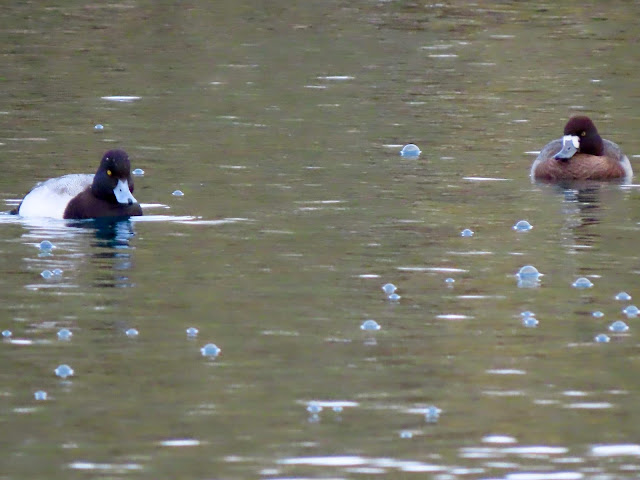Thursday, January 31, 2020
Ever since I've started living each day on its own terms, I've done less and less planning of my activities and frequently they are spur of the moment. Having visited the Salt River less than a week ago, my urge was to check out the Gilbert Riparian Water Ranch. In the 2.5 hours I walked the trails, checked the seven ponds, the fishing pond and canal, the temperature ranged between 38°-48°F from 7:45 to 10:20 a.m. A cloudy day, the winds were calm. Birds were easy to spot and those chirping and singing were clearly heard.
Wintering waterfowl are always a treat and less of a challenge to identify now than they were a mere three years ago. So, instead of just naming each duck, I compare and contrast it with others nearby. Why is this AMERICAN WIGEON not a GADWALLl? Why is this LESSER SCAUP not a RING-NECKED DUCK? etc.
Despite the overcast sky, photos turned out decently.
Many MALLARD and DOMESTIC DUCK (Mallard mix) also populate that pond. Out on the six other ponds the migrating species that settle in for the winter find enough food to maintain their months' long visits.
Herons and Egrets foraged on the edges of ponds or from higher perches. The SNOWY EGRET and GREAT EGRET are shown below, both eyeing prey from above the water.
[SNOWY is smaller with golden slippers; GREAT is taller with yellow beak, dark legs and feet.]
Below: GREAT BLUE HERON on high platform; BLACK-CROWNED NIGHT HERON, stealthy beside the pond.
The continuing out-of-its-territory ROSEATE SPOONBILL continued on Pond 2, obviously fluffed and huddled in our chilly weather. It's generally associated with Gulf States and Florida. With its head and bill tucked into its fluffed chest feathers, and one leg tucked up for warmth, this rare bird has lived at the Preserve since the end of September. Other ROSP have been sighted around the more southern parts of Arizona, too. Perhaps, loss of habitat elsewhere?
Two AMERICAN WHITE PELICAN have also stayed, as they have in past years. Unlike the Brown Pelican that dives, the WHITE PELICAN floats around on the surface, dipping is long bill under the water, filling its pouch with fish. Note the fibrous nodule growing on the upper bill of one of the pelicans. It's associated with breeding and will disappear after chicks are born. The black wing tips are not visible in the perched pelican but clearly seen in flight.
In winter months, most ponds provide enough water for copious bird species to survive. It was a great way to end birding year 2020!
As usual, click the link below to look at the eBird report filed for this date.
HAPPY NEW YEAR!
* * *
View this checklist online at https://ebird.org/checklist/S78317540













No comments:
Post a Comment